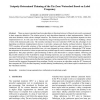Free Online Productivity Tools
i2Speak
i2Symbol
i2OCR
iTex2Img
iWeb2Print
iWeb2Shot
i2Type
iPdf2Split
iPdf2Merge
i2Bopomofo
i2Arabic
i2Style
i2Image
i2PDF
iLatex2Rtf
Sci2ools
JMIV
2007
2007
Uniquely-Determined Thinning of the Tie-Zone Watershed Based on Label Frequency
There are many watershed transform algorithms in literature but most of them do not exactly correspond to their respective definition. The solution given by such algorithms depends on their implementation. Others fit with their definition which allows multiple solutions. The solution chosen by such algorithms depends on their implementation too. It is the case of the watershed by image foresting transform that consists in building a forest of trees with minimum path-costs. The recently introduced tie-zone watershed (TZW) has the advantage of not depending on arbitrary implementation choices: it provides a unique and, thereby, unbiased solution. Indeed, the TZW considers all possible solutions of the watershed transform and keeps only the common parts of them as catchment basins whereas parts that differ form a tie zone disputed by many solutions. Although the TZW insures the uniqueness of the solution, it does not prevent from possible large tie zones, sometimes unwanted in segmenta...
| Added | 15 Dec 2010 |
| Updated | 15 Dec 2010 |
| Type | Journal |
| Year | 2007 |
| Where | JMIV |
| Authors | Romaric Audigier, Roberto de Alencar Lotufo |
Comments (0)

